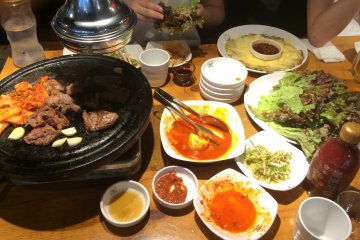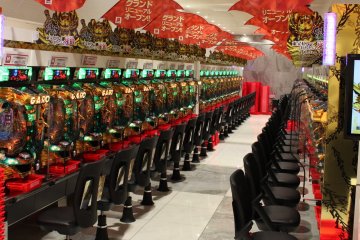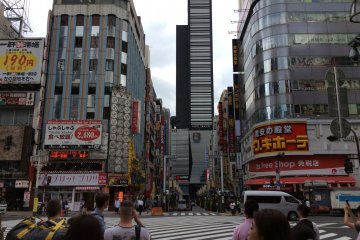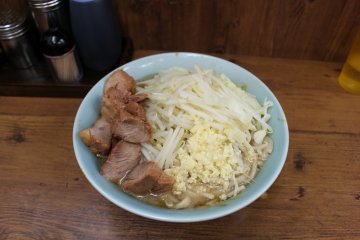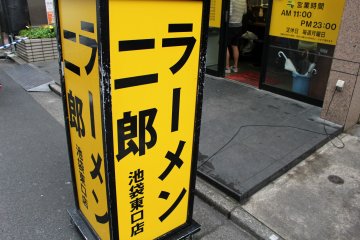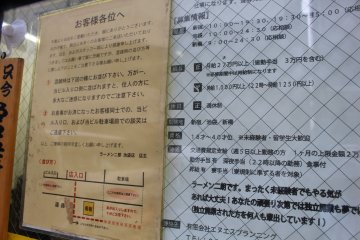Ramen Jiro (ラーメン二郎) is widely regarded as something of an institution amongst Japan's ramen veterans. Ever since the original Mito shop opened up in 1968 serving their signature variety of pork/soy sauce ramen, the name has grown into a franchise spanning over 30 stores across the Kanto region.
This is perhaps just as much fame as it is notoriety: the Jiro Ramen menu serves up brutal, heavy servings of thick, oily soup, fatty pork and lashings of garlic. Health-conscious readers would be wise to stop reading now. I, on the other hand, intrigued by tales of oversized portions, was determined to stop by the Ikebukuro branch to see what all the fuss was about.

Getting seated
I waited about 15 minutes to be seated, which isn't bad during the height of midday. Of course, expect queues to lengthen on weekends or when the sun's out. Nothing surprising there of course, but Jiro does have its own legion of disciples—the 'Jirorian' (okay, mostly salary men)—meaning a queue can be expected at most times. But being a ramen shop, the queue will move quickly.
The ticket vending machine is straightforward to navigate, with only 2 main choices to make. Ramen comes in small (¥700) and large (¥800), with or without pork topping (an extra ¥100-200 depending on volume). Most people opt for the regular, small serving and I will re-iterate what I've read elsewhere too – regular is bigger than your average bowl of ramen anywhere else, so you'd be very brave to go large on your first visit. I went for a regular-sized bowl, buta-iri (with pork), for just ¥800.

Before you're even seated, the chefs might ask a few things to those queuing e.g. whether you have a ticket and if you went for large serving (to help them prepare in advance). When seated, you'll be able to specify a couple of preferences e.g. how firm the noodles should be or how oily the soup should be – you can just 'futsuu' your way through ('normal'), until they ask about toppings (which might be just before they serve, or when you take a seat – just like the menu, every Jiro branch is slightly different).
What is Jiro-style?
By this time you may have had a chance to observe the mountainous bowls flanking you left and right along the counter. The basic portion is as generous a helping as it gets, but you can order extra garlic (ninniku), vegetables (yasai), pork fat and soy sauce (karame) for nothing extra. After briefly surveying what most people were eating, I settled for extra garlic. "Yasai mashi, ninniku mashi" (extra veg, extra garlic) is otherwise a common chorus in Jiro land.
The bowl landed heavily on the counter—plonk!—revealing a mountain of pork, bean sprouts and cabbage, with a dollop of fresh garlic on the side. I quickly pondered the madness of so much garlic, then realising my schedule was free of any more meetings that day, proceeded to dig in.
Above all, it was an addictively good ramen experience – of course I'm not talking about any delicate umami notes here, but a rich, intense, fatty pork ramen that is truly a guilty pleasure as much as it is marathon to get through. What at first might shock you, most likely will have you craving that return journey a day or so later.
The soup itself is a thick, oily pork/soy sauce variety with suspended fat in there for good measure, nothing like the creamy, Hakata-style tonkotsu variety you might be familiar with. The noodles are thick and chewy, comparable to tsukemen-style or udon, and will slow you down the more soup they absorb. The pork topping is chunky and very fatty. The garlic, pretty much an assumed topping at Jiro, is thrown on and by no means sparingly. The mountain of cabbage and bean sprouts is a health illusion, that might comfort the mind, but not your stomach from the wider experience. If traffic light labelling applied to ramen shops, this would be red across the board!
Whilst the experience was intense and almost bettered me, as I write this I can't help but think about my next visit.
The beginnings of Jiro
Alongside the official franchise, you can count a multitude of spin-offs or Jiro-inspired ramen shops dotting the Japanese landscape, all seeking to replicate the much-loved formula and proving there is so much interest in the original brand. Are you a 'Jirorian' or yet to try? Be sure to make a visit to Jiro and let us know what you think!





